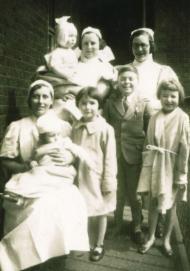Civilian Nurses

***
Tracing civilian nurses can be difficult. Before 1919 there was no register of nurses, and no national regulation or standards for nurse training. During the 1860s and 1870s training was normally for one year, and it was considered that most of what was essential could be learnt in that short time. During the last decades of the nineteenth century the realisation dawned that a longer period of training was necessary to produce a 'professional' nurse. However, hospitals were not compelled to train nurses for three years, with the result that nursing became a two tier system with what some regarded as 'proper' nurses, who had completed three years training in a large general hospital, and 'the others.'
The Nurses Registration Act of 1919 ended many years of conflict within the profession, and for the first time set standards for training, examination, and registration. From 1922 the General Nursing Council produced a yearly register of all trained nurses who had satisfied them that they had reached the required standard for admission, and copies of these registers for England and Wales are available to view at The National Archives, Kew, in class DT10. They give details of all women admitted to the Register and who had notified them of their continuing wish to practice by the September of the year prior to that of publication. The early registers give:
- Number on the Register
- Surname
- Forenames
- Permanent home address
- Training hospital with dates and qualification obtained
As a condition of the Nurses Registration Act 1919, many existing nurses were entered on the first registers, although they did not comply with the strict conditions of training that were enforced later. This means that many women who trained as early as 1890 are on the register of nurses, as long as they were still active in nursing in 1922.
For information about the location of Registers for nurses registered in Scotland or Ireland, and several other sources related to nurses, see the Royal College of Nursing site here:
Royal College of Nursing - Tracing Nurses
Midwives
The Midwives Act of 1902 established the Central Midwives Board and brought into law supervised training, registration and regulation of women who were practising as midwives. The Registers of the CMB are also held at The National Archives in class DV7 and also contain details of women who were practising prior to July 1901 and whose status was accepted without further training or examination.
***
A word about England, Wales, Scotland and Ireland
Nurses have often made a habit of going a long way from home to train, and it is impossible to hazard a guess at where they land! But as a general rule it seems that:
- English and Welsh women were more likely to remain in England or Wales to train; they were less likely to go to Scotland, and very unlikely to go to Ireland
- Scottish women were fairly evenly split as to whether they trained in Scotland or came to England, but many made the long journey south to train in London and other cities
- Irish women were more likely to train in Ireland, particularly in the late nineteenth and early twentieth century. Later on it became very fashionable for them to come to England to train, but that was far outside the period of my research!
- London had more nurse training places available during this period than several other large cities combined - it has always acted as a magnet for women from throughout the United Kingdom and Ireland
***